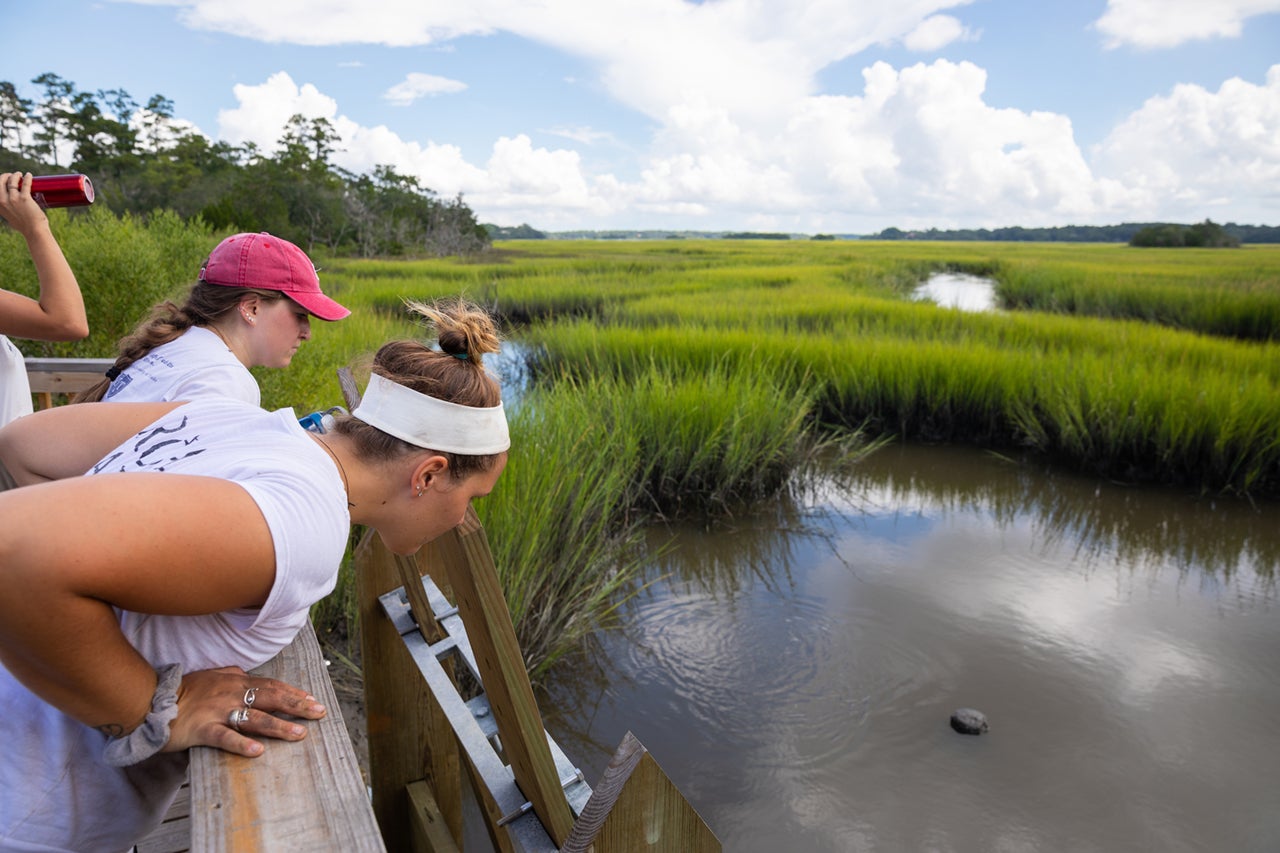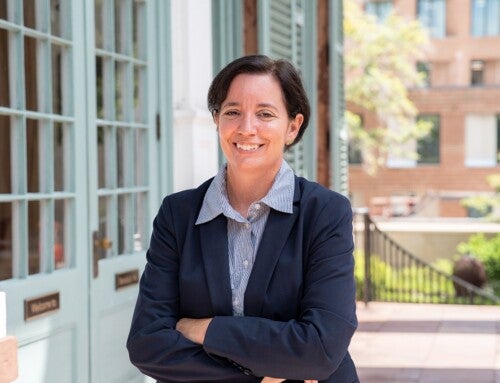Above: Students look out on marshlands at Stono Preserve. (Photos by Mike Ledford and Heather Moran)
With a variety of ecosystems and no shortage of plants and wildlife, the College of Charleston at Stono Preserve offers students and faculty a myriad of opportunities to take in and learn about the natural world of the Lowcountry.
Bequeathed to the College in the 1990s by the late naturalist John Henry Dick, this majestic 981-acre property along the Stono River features longleaf pine forests, wetlands, savannas, tidal marshes, as well as brackish, saltwater and freshwater ponds. A renowned ornithologist and painter of birds, Dick inherited the property from his mother in 1941 and made it his year-round home. It was his “other Eden,” where he found inspiration for his artwork. To protect and preserve his beloved estate, Dick placed a conservation easement on the entire property and left it to the College to use for education and research.
Today, Stono Preserve hosts students for a variety of classes in the sciences, art and history, among others. And the five-acre student garden there offers hands-on experience with a variety of modern and historic gardening techniques.
“A lot of students who are on the downtown campus, they just don’t realize Stono Preserve is only 17 miles away,” says Matt Rutter, biology professor and academic director of Stono Preserve. “And while our downtown campus is beautiful, of course, it’s an urban campus. And so, a lot of students come out here and are just amazed that this is part of the College.”
The College Today caught up with Rutter and Lucy Davis, program coordinator of the Master of Science in Environmental and Sustainability Studies Program, which includes the Student Gardens, to learn more about the landscape of Stono Preserve, how CofC students and faculty are leveraging the natural environment there for classes and research, and what students are growing in the garden. And explore the grounds and garden at Stono Preserve with Rutter and Davis in the latest episode of Speaking of … College of Charleston, CofC’s official podcast.

Biology Professor Melissa Hughes looks for birds at Stono Preserve with students in her ornithology class.
What kind of learning and research opportunities does Stono Preserve offer our students?
Rutter: We have a number of different classes that come out here. So, we have a class in herpetology, they come out and they study all of the reptiles and amphibians. We have an entomology class that studies insects. We have hydrology courses that come out and look at the water levels. We also have students who do research out here, both undergraduate and graduate research projects. We have some students right now who are studying the bird abundances in different habitats on the property. This is a place where students can easily come out and see lots of birds and different kinds of things that are harder to see and experience on the downtown campus.
In addition to all of the academic opportunities, what kind of conservation projects are available for students to get involved in?
Rutter: We’ve had students out here who’ve been planting trees. We have had them put up a bunch of bluebird boxes all throughout sections of the property. And I have seen bluebirds and other kinds of birds using those boxes like crazy. So that’s been fantastic to see that immediate impact.
They’ve been surveying the trees to see how our new trees are doing and some of the areas where we’re trying to enhance the diversity of the forest a little bit. We have a longleaf pine restoration area and we’ve had students repairing some of those areas where we’ve lost some trees due to tropical storms, and they’ve been planting new trees to go along with it. Part of the management plan here is to have periodic burns in the longleaf pine areas and so we’ve had some students get involved in that. So, there are a lot of conservation opportunities.
Do any of the property’s three ponds lend themselves to student and faculty activities?
Rutter: I know that our biology of fishes class has come out here and used the ponds as a way to look at some different fish. Geology students also have done a lot of monitoring. Sometimes you’ll see some wells that they’ve dug to see how there’ve been changes in the levels of salt in the water underground. With climate change and changing sea levels, we’ve seen some greater salt intrusion into the soils here, and so they are monitoring that. Our geology faculty use these wells both for classroom purposes – a lot of students in a class will come and learn how to build one of these wells – and they use it for water monitoring to see what’s actually happening at this location.
The student garden at Stono Preserve is the College’s largest student garden, correct?
Davis: Yes, this is about five acres. Eventually, we’re hoping to clear about 10 more acres. My ultimate goal is to put in a fruit orchard, which would be really cool! This is an educational garden space: So, what you’ll see here is a lot of different types of growing. We have raised beds. We have an herb garden. We have a vertical garden. We have row crops. We have our Hidden Hands bed. So, this garden fills many roles.
What are you growing in the garden right now?
Davis: Right now, we have tomatoes; we have cucumbers; we have squash; we have onions; and we still have some kale. We have herbs growing. We also have a lot of areas where we let the weeds grow up and we have wildflowers in those weeds, too, because we have bees, so we want to keep some of our flowers for our bees. We also have tons of peppers that are growing and okra.
Where does the produce grown here go?
Davis: We harvest, typically, every Thursday, and that’s from our downtown gardens and from our Stono garden. We do a harvest on Thursday so that we can give all of our produce away on Fridays. We typically give it to food banks or different organizations that prepare food for our community. And that’s the Charleston community in general, not just the College of Charleston community. Most frequently, we give to the Stone Soup Collective, which provides vegetarian meals with local produce.
What are some of the organizations the Student Gardens partner with in the community?
Davis: We partner with groups of all ages. We bring a lot of kids out here to Stono through Kids on Point, Cub Scouts of America and Project Inspire. We also partner with the Green Heart Project, which is a school-based program that puts farms and gardens at schools and then integrates those gardens into the curriculum. We also partner with the Charleston Area Beekeepers Association to support our six educational hives at Stono Preserve. We also partner with the Lowcountry Food Bank, Stone Soup Collective and One80 Place by providing food. And we provide lettuce and other greens for the sea turtles at the South Carolina Aquarium.






